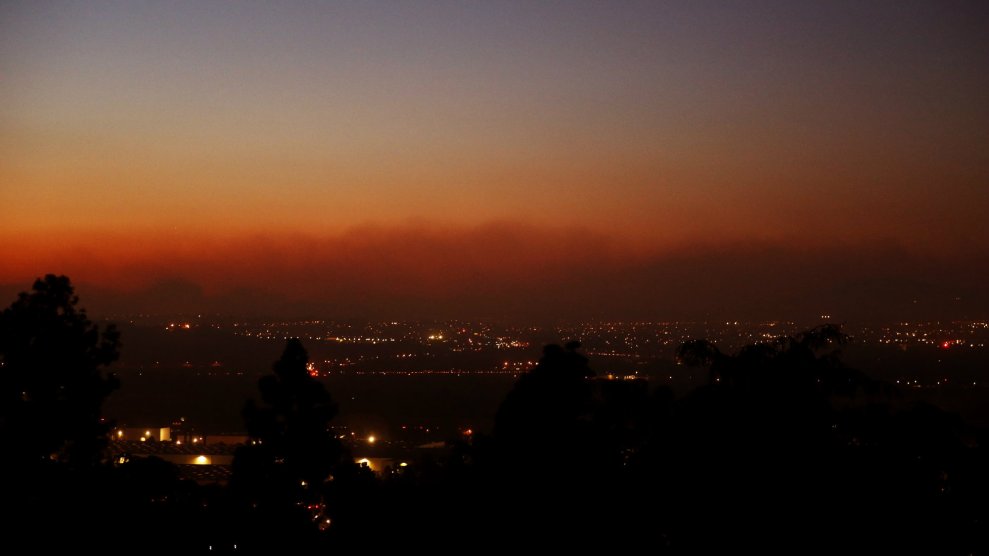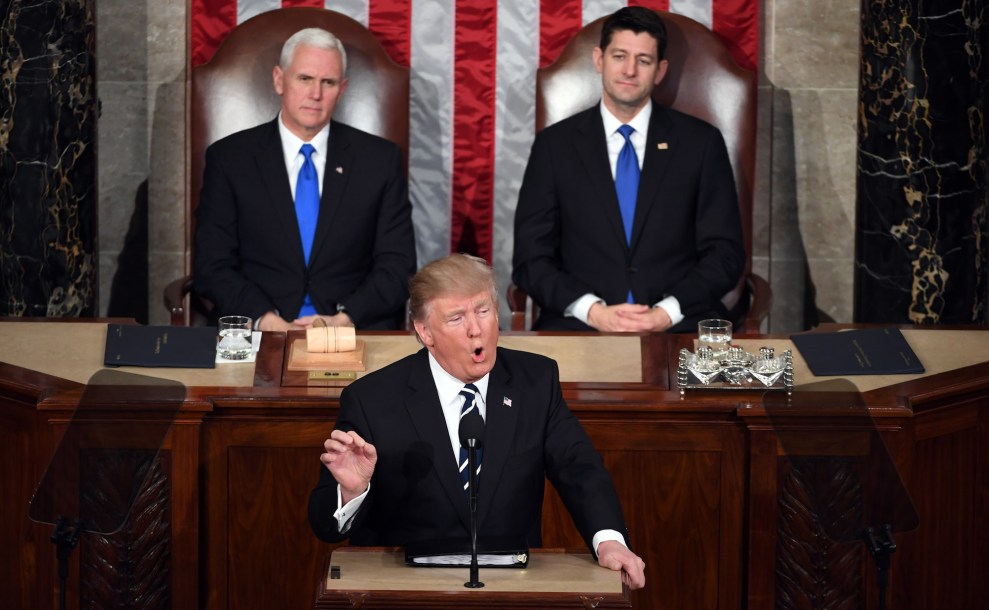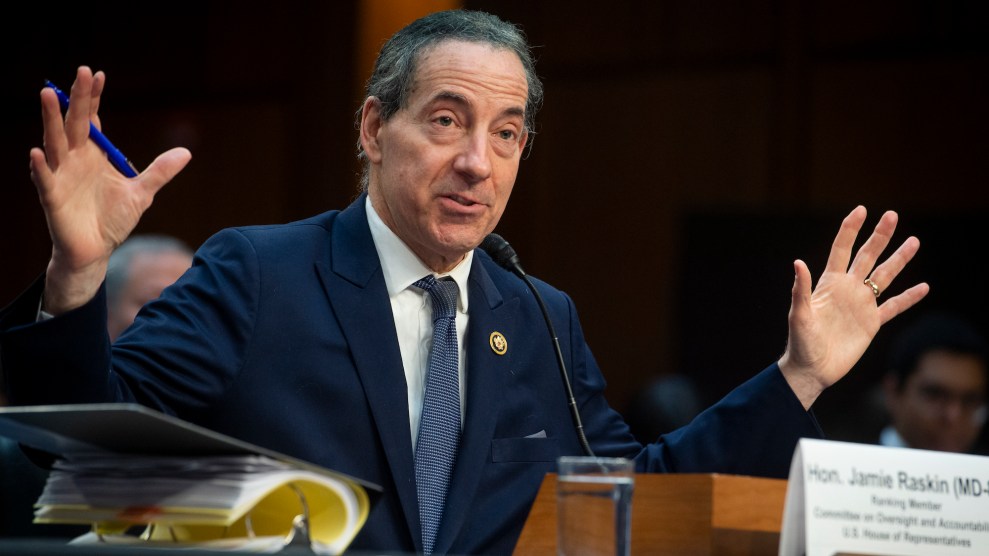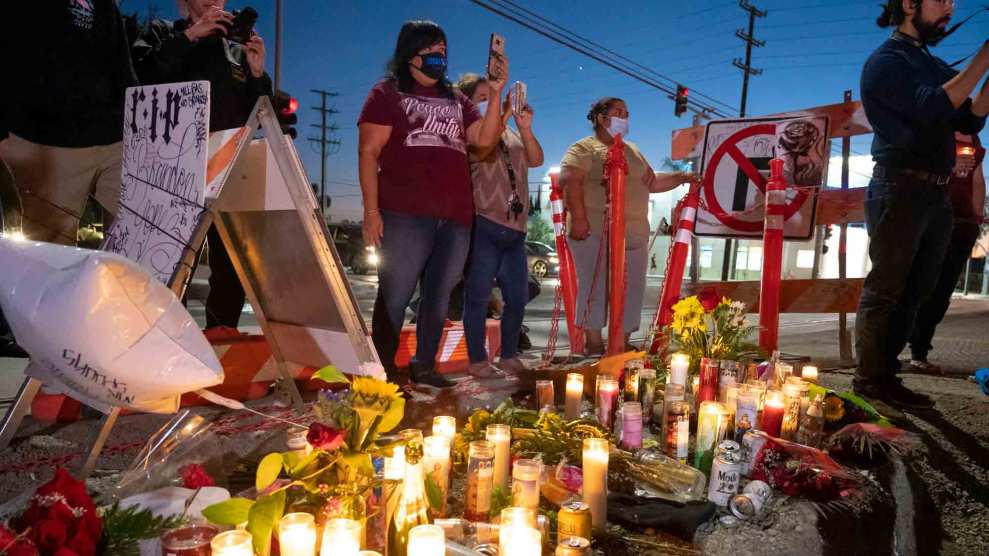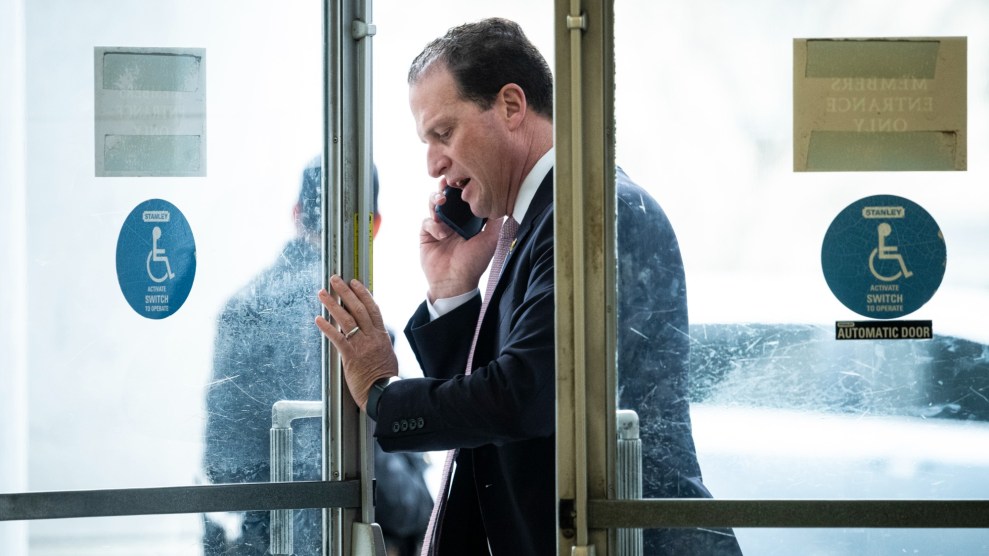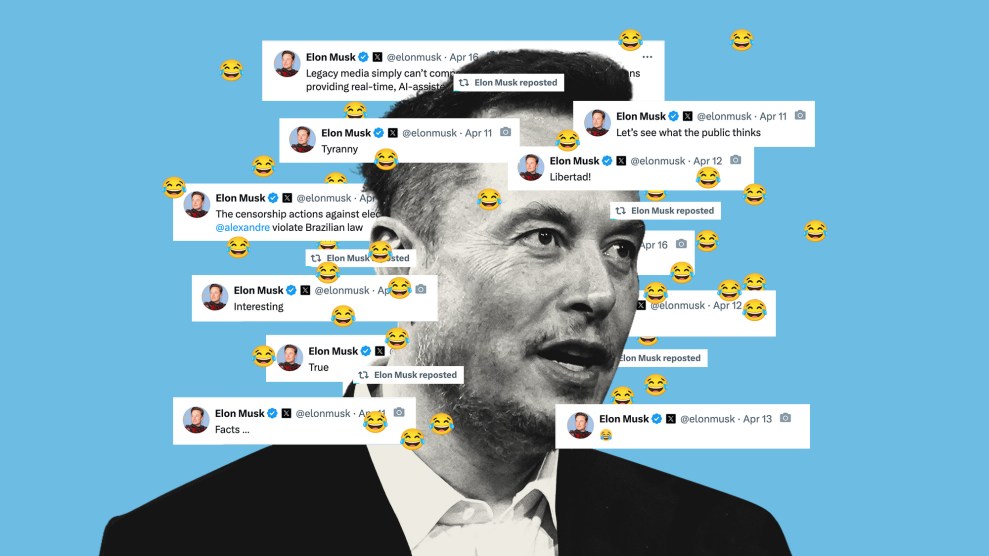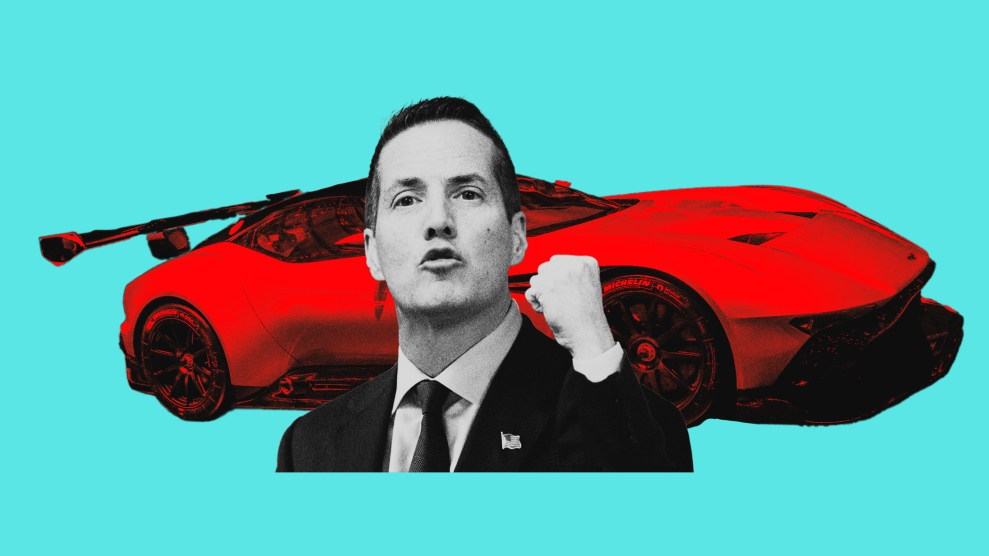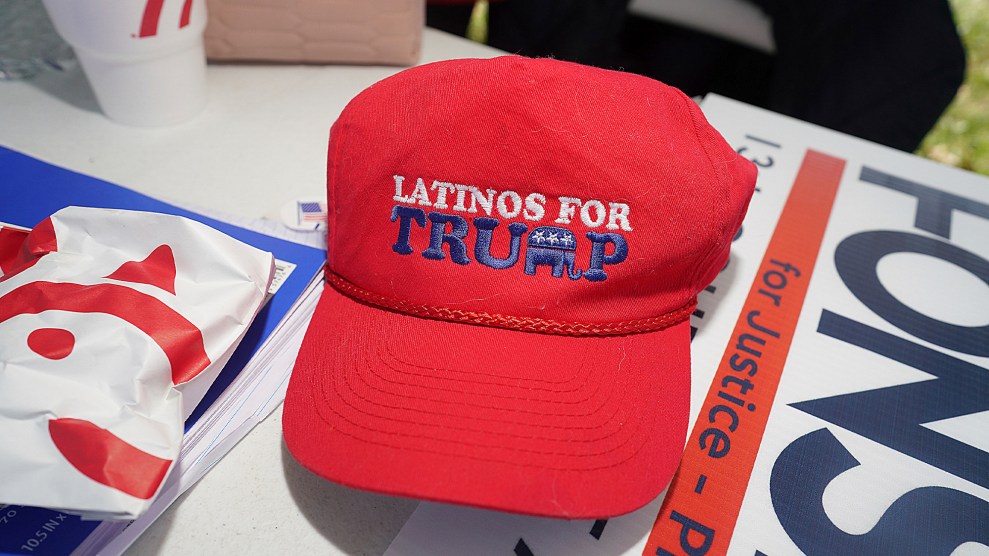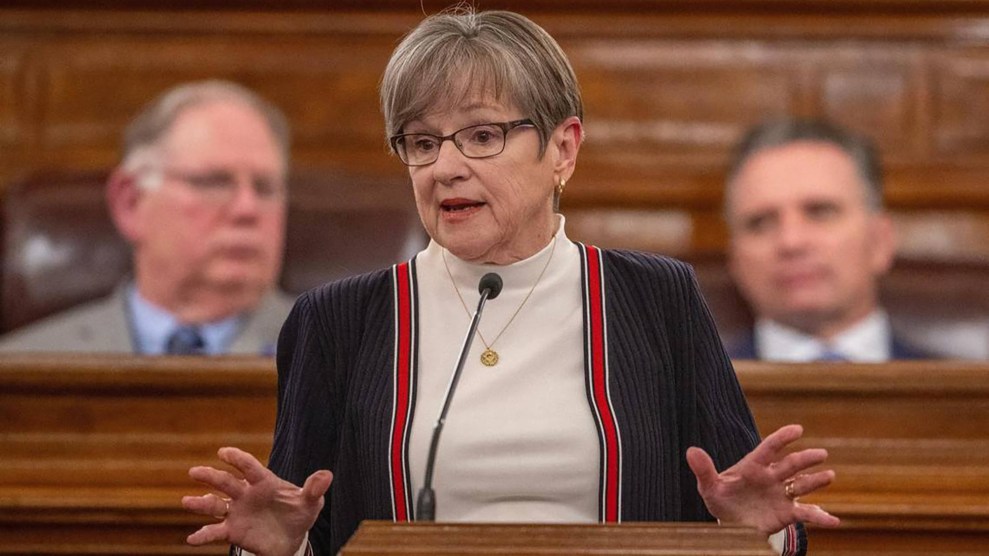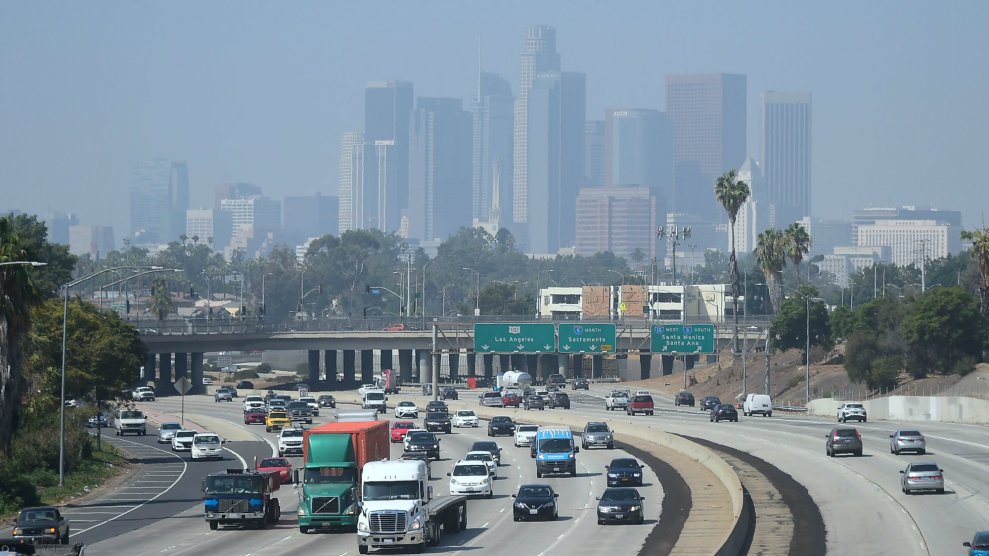
Frederic J. Brown/AFP/Getty Images
This story was originally published by Reveal. It appears here as part of the Climate Desk collaboration.
Last spring, air pollution researchers from around the world gathered to discuss their latest findings. Among them were scientists who led landmark studies linking smog and soot to deadly health problems.
So it was shocking when one speaker essentially told everyone in the room that they were wrong.
In his half-hour presentation, Tony Cox, a risk analyst from Denver, claimed that researchers are overstating the dangers of air pollution. He explained how his own statistical modeling of health data found no connection between dirty air and respiratory problems or heart attacks.
Scientists and others at the Health Effects Institute annual conference were appalled. Some added to their speeches what they had thought was obvious: Yes, air pollution really is dangerous.
Cox might have been just shrugged off as a provocateur, a denier of established science. But he leads the Trump administration’s panel of scientists that offers advice on how to protect the health of about 126 million Americans who live in smoggy and sooty places.
In that role, he’s in a prime position to spread his skepticism of the science of air pollution: The Environmental Protection Agency is poised this year to review its health standards for fine particles known as PM2.5 and ozone, the main component of smog.
These decisions, scientists say, literally could mean life and death for people in cities across the United States.
The EPA’s seven-member Clean Air Scientific Advisory Committee, which has been completely remade under President Donald Trump, is responsible for reviewing the science and advising the EPA on what level of pollution is unhealthy. Cox was appointed a year ago, and earlier this month, all remaining holdovers from the Obama administration were replaced with new appointees, including two who also downplay the threats of breathing polluted air.
Powerful industries—such as power companies, vehicle manufacturers and oil companies—oppose tighter health standards because they would force states to adopt costly rules that cut emissions.
According to documents obtained through the Freedom of Information Act, Cox was nominated for the science board’s top position by the US Chamber of Commerce, which has sued the EPA multiple times in an effort to loosen air pollution standards. The nomination came from Dan Byers of the chamber’s Global Energy Institute, who leads “efforts to promote and maintain coal’s vital role in America’s energy system.”
Cox has made his living challenging established science on behalf of industry. He has worked as a consultant for more than a dozen companies or industry groups that lobby against clean air or worker safety rules and are major sources of pollution, according to his website. He consulted for the American Petroleum Institute, which represents oil and gas companies, and the Truck and Engine Manufacturers Association, which represents makers of diesel and gasoline engines. He also consulted for the mining industry and tobacco giant Philip Morris.
“Industries hire Cox to sow doubt about the scientific evidence, to make the case that agencies don’t have any proof,” said Celeste Monforton, a worker safety advocate who worked at the Department of Labor in the 1990s. “Already, there’s some reticence around regulation. If you can introduce more doubt, it can be very effective.”
In an interview, Cox said there is no proof that cleaning air saves lives. He also has written that there’s no link between fine particle pollution and human health and that the health benefits from reducing ozone are “exaggerated.”
“Folks talk a good game and maybe fool themselves and others for a decade or so with feel-good projections and estimates, while all the time, the public gets zero actual measurable health benefits in terms of reduced death rates caused by the intervention,” Cox said.
Numerous scientific studies around the world have reported the same results for two decades: Fine particles and ozone raise the risk of people dying from asthma, heart attacks, pneumonia and other serious lung and heart ailments, and cleaning the air reduces deaths and hospitalizations.
Cox is “clearly outside the mainstream,” said Chris Zarba, who led the EPA staff overseeing the science boards for six years until he retired in February. “He is not someone I would have picked. You want some diversity (on the board), you want some outsiders, but only up to a point.”
Air pollution experts also have raised concerns about the expertise of the rest of the panel, with only one member with a medical or health background. None is an epidemiologist, the primary discipline that investigates human health effects of pollution. Five of the seven are engineers or toxicologists.
George Thurston, who served on a subcommittee of the clean air board under Presidents George W. Bush and Barack Obama, is worried that the changes under Trump will skew the panel’s nonpartisan science advisory work.
“Special interests get ahold of it and misrepresent the results,” said Thurston, who directs a program studying human health effects of air pollution at New York University’s School of Medicine. “And all the time, you’re delaying the public health benefits of regulation. That’s the goal.”
No medical or health training
Cox’s background as a statistician—with degrees in risk analysis, mathematical economics and operations research—makes him an unconventional fit compared with the doctors and scientists who traditionally have led the air pollution panel. His focus is risk analysis, a mathematical field designed to bring order to uncertain situations in which data is scarce or messy. He has no medical or health training.
Cox is the editor-in-chief of Risk Analysis: An International Journal and was inducted into the National Academy of Engineering for “applications of operations research and risk analysis to significant national problems.” He designed a toolkit for analyzing cause and effect that he described as a “totally dispassionate and honest mechanical” means of clearing away statistical noise.
Cox relies on a strategy that’s commonly applied by major corporations seeking to limit regulation: He plays on the uncertainty inherent in all scientific analyses.
Take particulate matter, tiny pieces of soot a fraction of the diameter of a human hair, which come from burning fuel in smokestacks and vehicles. The particles can lodge in the lungs and enter the bloodstream, inflaming lung diseases such as asthma and raising the risk of a heart attack.
Long-term studies of multiple cities by Harvard University, the University of Southern California and other schools have linked reduced particulate levels to improved lung development and respiratory health in children and more deaths from heart attacks and lung diseases on days when fine particles increase.
But when Cox applies his statistical model to the same data, he reaches a different conclusion. That’s because he is searching for factors other than pollution that may drive deaths. For instance, when he analyzed data on 100 cities, he reported “no evidence that reductions in PM2.5 concentrations cause reductions in mortality rates.” Instead, his analysis concluded that it was temperature driving deaths. (Colder air can trap particles close to the ground, so the two factors often come together.) In other analyses, Cox pointed to income as a bigger factor than pollution.
Most of the evidence of health benefits “when looked at carefully turns out to consist of a mix of bad statistics, wishful thinking and irresponsible claims,” Cox said.
Epidemiologists say there’s a role for causal analysis like Cox’s. But they say it can’t replace the large studies that show what happens to people’s health when real-world pollutant levels rise and fall, combined with controlled experiments exposing people and animals. Cause and effect is extremely difficult to prove in public health; instead, scientists search for repeated associations between sickness and pollution levels.
For instance, when a Utah steel mill that was releasing soot into the air shut down for 13 months, the number of children admitted to hospitals for asthma attacks and bronchitis dropped, according to one study. Once the mill reopened and the emissions returned, admissions nearly doubled.
The researchers couldn’t declare without a doubt that closing the mill improved children’s health. But C. Arden Pope, a Brigham Young University professor and the study’s author, said the evidence leaves no other conclusion. He said no one has found a “magical confounder” that could explain why twice as many children are hospitalized with asthma attacks when the steel mill operates.
“A lot of what (Cox) says is manufactured uncertainty,” said Gretchen Goldman, research director of the Center for Science and Democracy at the Union of Concerned Scientists. “If there’s a science-based rule, opponents will try to emphasize the uncertainty in the science to obscure its benefits.”
Industry ties on science boards
The air pollution board isn’t the only one the Trump administration has overhauled. Cox’s appointment came after then-EPA Administrator Scott Pruitt booted scientists from all advisory panels if they had received EPA research grants. That means most academics no longer qualify, while people with ties to polluting industries swamp the panels.
An investigation by Reveal from the Center for Investigative Reporting found that 16 of the Trump administration’s 18 replacements for the EPA’s larger, broader Science Advisory Board last year had industry ties. The board’s new chairman, Texas Commission on Environmental Quality toxicology director Michael Honeycutt, has cast doubt on the effectiveness of EPA clean air rules. Another member, Robert Phalen, once said modern air is “a little too clean for optimum health.”
Cox’s work for industry often has disputed science supporting regulations. In 2014, Cox spoke at a public hearing on behalf of the American Chemistry Council, which represents chemical companies, arguing against a proposed federal rule tightening limits on worker exposure to silica dust. He called the government’s assessment, which linked low levels to lung disease, “not ready for prime time.”
His testimony prompted a fiery retort from a nationally known scientist: Robert Park of the National Institute for Occupational Safety and Health told the hearing audience that it was “ludicrous” for Cox to question “100 years of research” showing silica’s health effects.
“We aren’t stupid,” Park told him.
For diesel engine manufacturers, Cox criticized science that links diesel exhaust to lung cancer. Diesels are a major source of the fine particles that his panel will review.
A 2012 study by Cox, partially funded by Philip Morris, found that smoking 10 or fewer cigarettes per day didn’t raise the risk of heart disease. According to his website, he also consulted for the tobacco company multiple times between 2004 and 2009, including questioning whether smoking causes lung cancer and other lung diseases.
The National Mining Association retained him in 2011 to testify against a rule that would limit miners’ exposure to coal dust to combat black lung disease. In addition, the National Stone, Sand and Gravel Association funded a 2013 paper he wrote questioning the links between cancers and proximity to California rock mines.
Industry representatives often have served on EPA panels. George Wolff, a scientist for General Motors, led the clean air panel for three years in the 1990s. But under previous administrations, they were in the minority, outweighed by voices from academia.
EPA Acting Administrator Andrew Wheeler earlier this month disbanded a large subcommittee of scientists that reviewed health effects of particulates and scrapped plans to create one for ozone. That means the EPA will rely on the seven panelists rather than two dozen or more specialized experts when it decides whether to loosen or tighten air standards.
“You can’t say you are serious about the views of the scientific community and then limit the expertise at the table,” said John Bachmann, a former EPA director for science policy on air quality under the George W. Bush administration. “It is a travesty.”
One new air pollution board member is Timothy Lewis, an aquatic ecology engineer with the Army Corps of Engineers whose work focuses on controlling invasive species in waterways. He has no apparent expertise in human effects of air pollution.
Another new member is Sabine Lange, a Texas Commission on Environmental Quality toxicologist who has publicly questioned the impact of ozone pollution on health and collaborated with Honeycutt on a study criticizing the EPA’s benefits analysis for the standard.
Joining them is Steven Packham, a Utah Division of Air Quality toxicologist. Even though Salt Lake City has some of the nation’s worst particulate pollution, Packham said in 2016, “We don’t have enough data to say PM2.5 is causing the health effects that we’re attributing to it.”
The sole medical voice on the panel is Dr. Mark Frampton, a pulmonologist with the University of Rochester Medical Center who has studied the health effects of air pollutants, including leading the largest systematic study exposing patients to ozone. In a 2011 editorial in a medical journal, Frampton said that as health effects emerge at lower levels of ozone, the economic costs could become untenable, so “we need to consider new regulatory approaches in achieving the cleanest air possible and minimizing harm.”
Stakes are high in many cities
There’s a lot at stake for the public: More than 124 million people in 201 US counties live in places where the air is considered unhealthy for ozone, and more than 23 million people breathe air with unhealthful levels of fine particles. Included are the Los Angeles region, Houston, New York, Phoenix, Pittsburgh and Sacramento, California. The elderly, children and people with cardiovascular or lung diseases are most at risk.
The clean air panel is the scientific filter for EPA policymakers who set the health standards. First, the panelists review a massive collection of studies assembled by EPA staff to say where the science is strongest and where uncertainty exists. That’s followed by an assessment of what the potential health effects are at various pollution levels.
Finally, the panel produces a recommendation for a safe air quality level. The federal Clean Air Act mandates that the standards be bounded strictly by science, not costs. The EPA does not have to adopt the recommendation, but a definitive scientific review from the panel is hard for the agency to ignore.
“Cox is someone who can go out and put in all kinds of weasel words,” said Bachmann, the former EPA official. “He can weaken all the evidence we have.”
Cox said he isn’t trying to stop the EPA from reducing pollution, but wants to offer “a more accurate and nuanced understanding of what we can control.” He said he hopes he can “help clarify and communicate clearly and precisely about what is known and what remains uncertain.”
But the new makeup of the science panel comes with other changes to the EPA’s review process for clean air standards. Pruitt in May outlined a streamlined review—removing some opportunities to challenge faulty assumptions—and asked the science panel for the first time to advise the EPA on adverse “social, economic or energy effects” of attaining standards.
Zarba, the former EPA official, worries that those changes could give air pollution skeptics such as Cox more power to bake in their conclusions from the start.
“If you cherry-pick the science a certain way,” Zarba said, “you can get whatever answer you want.”
